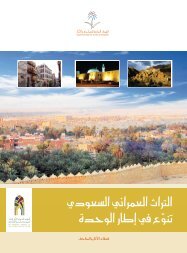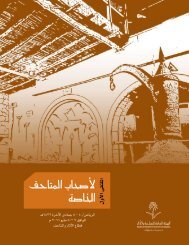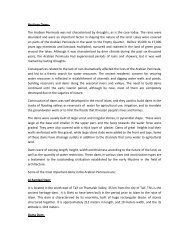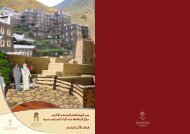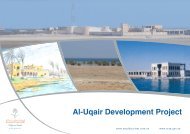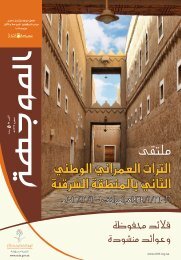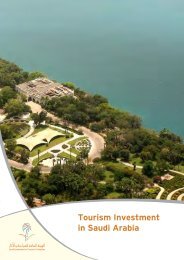Saudi Arabia - Civilization meeting place
Saudi Arabia - Civilization meeting place
Saudi Arabia - Civilization meeting place
Create successful ePaper yourself
Turn your PDF publications into a flip-book with our unique Google optimized e-Paper software.
Lihyanite inscription, 5th–2nd<br />
centuries BC, Al-Ula<br />
Mercantile Cities<br />
A number of centers of civilization<br />
continued to flourish along the<br />
<strong>Arabia</strong>n Gulf during the Assyrian,<br />
Babylonian, Achaemenid and<br />
Parthian eras, from the ninth to<br />
the second centuries BCE, and<br />
through the era of the successors<br />
of Alexander the Great, whose<br />
intent was to invade the <strong>Arabia</strong>n<br />
Peninsula. The eastern region of<br />
the <strong>Arabia</strong>n Peninsula witnessed<br />
a period of increasing stability<br />
during the Seleucid era. The city of<br />
Gerrha is the best example of the<br />
high level of prosperity and wealth<br />
attained by towns<br />
in eastern <strong>Arabia</strong> during this time,<br />
and can be compared to that of<br />
certain southern <strong>Arabia</strong>n towns<br />
such as Marib.<br />
The centers of the <strong>Arabia</strong>n<br />
interior were important outposts<br />
along the trading network, which<br />
crisscrossed the Peninsula from<br />
the southwest to the northeast,<br />
ending in southern Mesopotamia.<br />
Many mercantile towns situated<br />
along the route from a point<br />
southeast of Thaj to Qaryat al-Faw<br />
and Thaj, also flourished during<br />
this period for similar reasons.<br />
Among the most important<br />
mercantile towns during the first<br />
and second millennia BCE were:<br />
1. The settlement of Arcomy<br />
in the center of the Jabal<br />
Shammar region.<br />
2. The centers situated<br />
along the length<br />
of Wadi Sirhan,<br />
such as al-<br />
Jawf, which<br />
exercised<br />
its<br />
authority over a wide area of<br />
central and northern <strong>Arabia</strong><br />
during the middle of the first<br />
millennium BCE.<br />
3. Simultaneously, developments<br />
took <strong>place</strong> that led to the<br />
unification of communities on<br />
the Najd plateau, along the<br />
Tuwayq ridge and in Wadi<br />
al-Dawasir. The renowned<br />
kingdom of Kindah took the<br />
city of Qaryat al-Faw as its<br />
trade and political capital.<br />
The Najran site<br />
Gutter” with inscription, c. 2nd century, Najran<br />
4. Najran: Najran witnessed a<br />
long period of settlement at<br />
the site of al-Ukhdud, which<br />
was mentioned in the Holy<br />
Quran (Sura: 85/4). The ruins<br />
of al-Ukhdud are to found in<br />
the village of al-Qabil on the<br />
southern bank of Wadi Najran;<br />
the site is considered one of<br />
the most important ancient<br />
sites in Najran Province.<br />
Age of the Late<br />
<strong>Arabia</strong>n Kingdoms<br />
The <strong>Arabia</strong>n Peninsula was<br />
affected by the violent conflict,<br />
which erupted between the<br />
Byzantine and Sasanian empires<br />
for control of the ancient world. As<br />
a result, the relative stability that<br />
had been enjoyed by the <strong>Arabia</strong>n<br />
kingdoms dissipated and was<br />
re<strong>place</strong>d by turmoil and chaos.<br />
At the same time, the unity of the<br />
kingdom of Kindah in the center of<br />
the <strong>Arabia</strong>n Peninsula collapsed<br />
as <strong>Arabia</strong> turned into a platform for<br />
violent intertribal strife during the<br />
time known as the Jahiliyyah, or<br />
the pre-Islamic era.<br />
Gilt bronze appliqué adorning the bed head,<br />
1st–3rd century, Qaryat al-Faw



